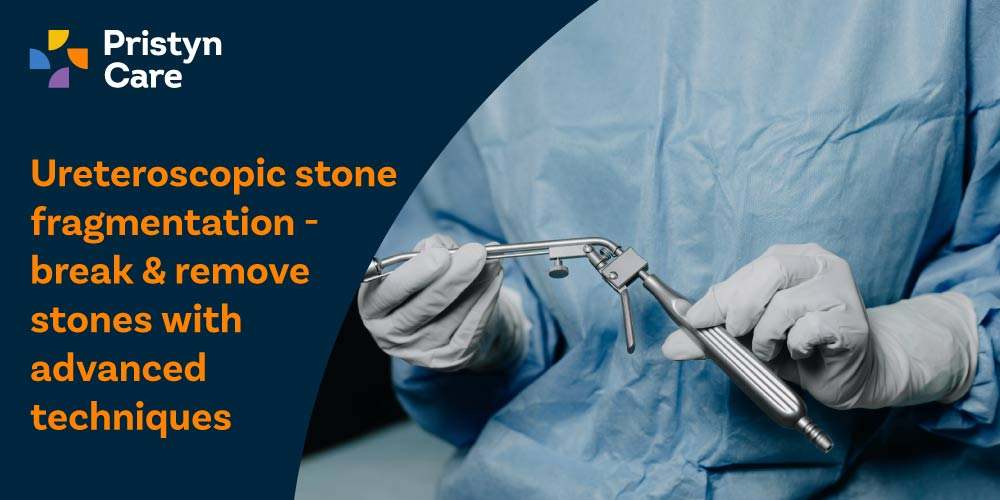
Kidney stones can be painful and disruptive, but ureteroscopic stone removal is an advanced technique that helps break and remove stones efficiently. This minimally invasive approach ensures a quicker recovery, fewer complications, and effective relief for patients suffering from kidney and ureteral stones.
In this blog, we will discuss ureteroscopy for stone fragmentation, advanced techniques, recovery, risks, and benefits, making it easier to understand for everyone.
Table of Contents
What Is Ureteroscopic Stone Removal?
Ureteroscopic stone removal is a minimally invasive kidney stone removal procedure where a thin, flexible or rigid ureteroscope is inserted into the urinary tract to locate and remove kidney or ureteral stones. This procedure is especially beneficial for stones that are too large to pass naturally or are causing severe pain and blockage.
Why Is Ureteroscopic Stone Removal Performed?
This procedure is recommended for:
- Stones lodged in the ureter that do not pass naturally.
- Kidney stones causing pain, infection, or obstruction.
- Patients with multiple or large stones that require fragmentation.
- Individuals who are not suitable for shock wave lithotripsy (SWL) or other treatments.
How Ureteroscopic Stone Removal Works?
The procedure involves breaking the stones into smaller fragments and then removing them through the ureteroscope. URS stone treatment can be performed with different techniques, including:
1. Laser Treatment for Kidney Stones
One of the most effective methods for stone fragmentation is laser treatment for kidney stones. This technique uses a high-powered Holmium:YAG laser to break stones into tiny fragments, making them easier to extract or pass naturally.
How the laser treatment works:
- A thin laser fibre is inserted through the ureteroscope and directed towards the stone.
- The laser emits pulses of high-energy light, which precisely targets and breaks the stone into small pieces.
- Depending on the size and composition of the stone, the urologist can choose between two techniques:
- Fragmentation technique – The laser breaks the stone into several small pieces, which are then removed using a stone basket or forceps.
- Dusting technique – The laser pulverises the stone into fine dust-like particles, which naturally pass through urine over time.
- This technique is highly precise and minimises damage to surrounding tissues and organs.
- It is particularly effective for hard stones that are resistant to other treatments.
Advantages of laser treatment for kidney stones:
✔ Minimally invasive, with no need for incisions.
✔ High success rate, even for large or complex stones.
✔ Reduces the need for additional procedures, as stone fragments are effectively broken down.
✔ Lower risk of complications, such as ureteral injury.
2. Basket Extraction for Stone Removal
For stones that are already small enough or have been fragmented using a laser, the urologist may use a stone retrieval basket to remove them.
How basket extraction works:
- A small wire basket is inserted through the ureteroscope.
- The basket is carefully opened around the stone or stone fragments.
- Once the stone is secured, the basket is slowly pulled out, removing the stone along with it.
- This method is particularly useful for stones in the lower ureter or fragments left after laser treatment.
Advantages of basket extraction:
✔ Quick and efficient method to remove stones.
✔ Minimises the risk of stone fragments getting stuck in the urinary tract.
✔ Helps in cases where laser treatment alone is insufficient.
3. Dusting Technique for Stone Fragmentation
The dusting technique is a variation of laser treatment for kidney stones, designed to turn large stones into tiny, dust-like particles that can be flushed out naturally through urine.
How the dusting technique works:
- Instead of breaking the stone into large fragments, the laser pulverises it into fine dust.
- This method eliminates the need for retrieval tools like baskets or forceps.
- The patient is instructed to drink plenty of water after the procedure to ensure all dust-like fragments pass out through urine.
Advantages of dusting technique:
✔ No need for stone retrieval – fragments pass naturally.
✔ Less risk of ureteral damage, as large fragments do not need to be pulled out.
✔ Reduces the risk of stone recurrence, as tiny particles are completely flushed out.
Types of Ureteroscopes Used in URS Stone Treatment
In URS stone treatment, a ureteroscope is the primary tool used to access, visualise, and remove stones from the ureter or kidney. Ureteroscopes come in two main types – rigid and flexible, each designed for specific conditions and stone locations. The choice of ureteroscope depends on the size, location, and complexity of the stone, as well as the patient’s anatomy.
1. Rigid Ureteroscope
A rigid ureteroscope is a straight, inflexible instrument mainly used for stones located in the lower or mid-ureter. It provides high-definition visuals, enabling precise stone targeting and removal.
When is a rigid ureteroscope used?
- For stones in the lower or mid-ureter, where flexibility is not needed.
- When a high-resolution view is required for precise stone fragmentation.
- When larger instruments such as stone retrieval baskets need to be used.
- For faster procedures, as rigid scopes provide better control and access.
Advantages of a rigid ureteroscope:
- Superior image quality, helping urologists detect even small stones.
- Better stability during stone fragmentation and extraction.
- Allows the use of larger instruments, increasing the efficiency of stone removal.
- More durable and less prone to damage compared to flexible ureteroscopes.
2. Flexible Ureteroscope
A flexible ureteroscope is a highly manoeuvrable instrument used for kidney stones and stones in the upper ureter. It can bend and rotate, making it ideal for laser treatment for kidney stones and other advanced techniques.
When is a flexible ureteroscope used?
- For stones located in the kidney or upper ureter, where flexibility is required.
- For laser stone fragmentation, as it allows better access to different angles.
- For multiple or complex stones, which need careful navigation and precision.
- When a minimally invasive approach is preferred, reducing trauma to tissues.
Advantages of a flexible ureteroscope:
- Can navigate through the kidney’s complex structure, accessing stones in difficult locations.
- Allows laser treatment for kidney stones with effective fragmentation.
- Reduces the risk of injury, as it can bend without excessive force.
- Improves patient comfort and reduces post-procedure pain.
Step-by-Step Procedure of Ureteroscopic Stone Removal
The ureteroscopic stone removal procedure is a minimally invasive kidney stone removal technique performed using a ureteroscope to locate, fragment, and extract stones from the ureter or kidney. It is usually done under general or spinal anaesthesia and allows for effective stone treatment with minimal recovery time.
1. Pre-Procedure Preparation
Before undergoing URS stone treatment, patients need to follow specific preparations for a smooth and safe procedure.
Medical evaluation and tests:
✔ A urinalysis is conducted to check for infections. If an infection is present, antibiotics are prescribed before the procedure.
✔ A CT scan, X-ray, or ultrasound is performed to determine the size, number, and location of the stones.
✔ Blood tests are done to assess kidney function and clotting factors.
Dietary and medication restrictions:
✔ Patients must stop eating or drinking at least 6-8 hours before the procedure.
✔ Blood-thinning medications, such as aspirin, may need to be stopped a few days before surgery.
Pre-surgical preparations:
✔ Some patients may require a temporary stent placement before the procedure to help dilate the ureter and make stone access easier.
✔ The doctor provides detailed instructions on what to expect on the day of the procedure.
2. The Ureteroscopic Stone Removal Procedure
The actual procedure follows a step-by-step process that ensures the safe and effective removal of stones.
Step 1: Inserting the ureteroscope
✔ The patient is given general or spinal anaesthesia for comfort.
✔ The ureteroscope is inserted through the urethra, bladder, and into the ureter or kidney.
✔ A sterile liquid is used to expand the ureter, improving visibility for the surgeon.
Step 2: Locating the stone
✔ The camera on the ureteroscope provides a clear image of the urinary tract.
✔ The urologist identifies the exact location of the stone and determines the best method for removal.
Step 3: Breaking the stone
✔ If the stone is too large to be removed intact, laser treatment for kidney stones is used to fragment it.
✔ The laser breaks the stone into smaller, more manageable pieces.
✔ The doctor may choose either the fragmentation technique (creating small removable pieces) or the dusting technique (pulverising the stone into fine dust).
Step 4: Removing the stone fragments
✔ Stone baskets or graspers may be used to remove larger fragments.
✔ Smaller fragments and dust-like particles are left to pass naturally through urine.
✔ If necessary, a ureteral stent is placed to keep the ureter open and ensure smooth passage of fragments.
Recovery After URS Stone Treatment
Recovery from URS stone treatment is usually quick, with most patients resuming daily activities within a few days. However, following proper aftercare is essential for healing and preventing complications.
Most patients go home the same day, but mild pain, burning during urination, and slight blood in urine are common for the first 24-48 hours. Drinking 2-3 litres of water daily helps flush out stone fragments and reduces discomfort. Resting for a day or two and avoiding heavy activities can speed up recovery.
If a ureteral stent was placed, temporary symptoms like urinary urgency, mild back pain, or bladder discomfort may occur until it is removed, usually within 5-14 days. Painkillers and antibiotics are prescribed to manage discomfort and prevent infections. Patients should avoid caffeine, alcohol, and excessive salt to prevent irritation.
Follow-up appointments ensure the ureter heals properly, and if needed, the doctor removes the stent. Patients should monitor for severe pain, fever, or difficulty urinating, as these could indicate complications. Long-term, hydration, dietary changes, and periodic check-ups help prevent future kidney stones.
Conclusion
Ureteroscopic stone removal is a highly effective, minimally invasive kidney stone removal method that ensures quick recovery, minimal discomfort, and a high success rate. With advancements like laser treatment for kidney stones, patients benefit from precise stone fragmentation and reduced risks.
By following post-procedure care guidelines, staying hydrated, and adopting a stone-prevention diet, patients can significantly lower the risk of recurrence. If you have kidney stones, consult a urologist to explore whether ureteroscopy for stone fragmentation is the best treatment for you.
With modern medical advancements, kidney stone treatment has never been safer or more effective!







